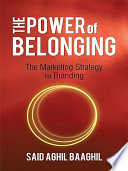

Emotional intelligence (EI) is presented as a key skill for fostering belonging in both personal and professional contexts. The author explains how EI involves recognizing and managing one's emotions and understanding the emotions of others. This skill is vital for creating connections, resolving conflicts, and building relationships. The book outlines how leaders with high emotional intelligence can better support their teams, enhance communication, and create a more inclusive environment. The author provides tools and techniques for developing emotional intelligence, emphasizing its role in promoting belonging.
Continue readingThe book emphasizes that belonging to a community is crucial for personal and professional growth. It explores how humans are inherently social beings and how a sense of community can foster collaboration, support, and innovation. By being part of a community, individuals can share resources, knowledge, and experiences that enhance their capabilities. The author presents case studies illustrating how organizations that cultivate a strong sense of community among their employees see improved morale, productivity, and retention rates. The idea is that when individuals feel they belong, they are more likely to contribute positively, take risks, and innovate.
Continue readingThe concept of psychological safety is central to the book's argument. It refers to an environment where individuals feel safe to express their thoughts and ideas without fear of judgment or repercussion. The author discusses how organizations that prioritize psychological safety encourage open communication and creativity. By fostering an atmosphere where team members can voice their opinions, organizations can harness diverse perspectives leading to better problem-solving and innovation. The book provides actionable strategies for leaders to create psychologically safe spaces, emphasizing the role of trust and mutual respect.
Continue readingThe author stresses the importance of inclusivity and diversity within communities and organizations. A diverse group brings a variety of viewpoints and experiences that can drive creativity and innovation. The book explores how inclusivity goes beyond just representation; it involves creating an environment where everyone feels valued and heard. The author provides examples of companies that have successfully embraced diversity and the tangible benefits they have reaped, including enhanced performance and employee satisfaction. This idea encourages readers to actively work towards creating inclusive spaces in their personal and professional lives.
Continue readingA shared purpose is presented as a foundational element of belonging. The book argues that when individuals align around a common goal or mission, it strengthens their connection to each other and the organization. The author illustrates how organizations with a clear and compelling purpose can inspire their members to work collaboratively and passionately. This shared purpose not only motivates individuals but also creates a sense of accountability and belonging. The book includes practical steps for leaders to articulate and communicate a shared purpose effectively.
Continue readingTrust is a critical component of belonging, and the book delves into how it can be cultivated within teams and organizations. The author discusses the various dimensions of trust, including reliability, openness, and competence. Through real-world examples, the book highlights the impact of trust on team dynamics and overall organizational performance. The author provides strategies for building trust, such as consistent communication, transparency, and recognizing contributions. The idea is that trust fosters collaboration and a sense of belonging, ultimately leading to enhanced performance.
Continue readingThe book discusses the dual role of technology in fostering and hindering belonging. On one hand, technology can connect individuals across distances and create virtual communities. On the other hand, it can also lead to feelings of isolation if not used mindfully. The author explores how organizations can leverage technology to enhance belonging, such as using collaborative tools that promote engagement and communication. The book also addresses the importance of balancing technology use with face-to-face interactions to maintain meaningful connections.
Continue reading